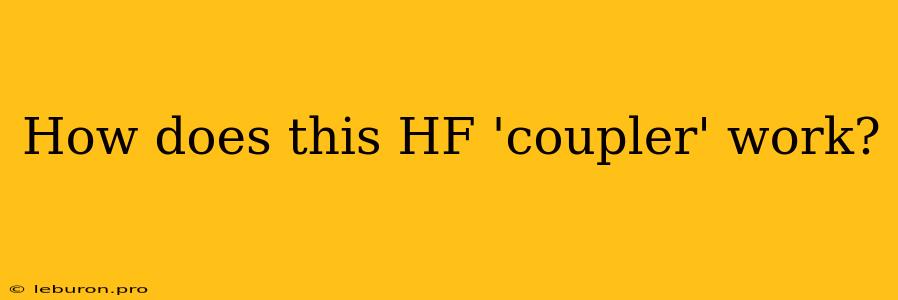The term "coupler" in the context of radio frequency (RF) systems, specifically those operating in the high frequency (HF) band, refers to a crucial component that facilitates the efficient transfer of power from a transmitter to an antenna. Understanding how this coupler functions is essential for optimizing signal transmission and ensuring the longevity of the RF system. This article delves into the inner workings of an HF coupler, exploring its various types, design considerations, and applications.
The Role of an HF Coupler
An HF coupler acts as a bridge between the transmitter and the antenna, effectively matching their impedance. Impedance, a measure of resistance to the flow of alternating current (AC), is a critical factor in RF systems. A mismatch between the transmitter's output impedance and the antenna's input impedance leads to power loss, reflected waves, and potentially damage to the equipment.
Impedance Matching: The Key to Efficient Transmission
The coupler's primary function is to achieve impedance matching. This involves transforming the transmitter's impedance to match the antenna's impedance, ensuring maximum power transfer. This matching process minimizes reflected power, which can travel back towards the transmitter, causing damage or instability.
Types of HF Couplers
Several types of HF couplers are used, each suited for specific applications and frequency ranges:
-
L-Network Coupler: This simple and common type employs an inductor and a capacitor to match the impedances. The values of these components are adjusted to achieve the desired impedance transformation.
-
Pi Network Coupler: Featuring two capacitors and one inductor, the Pi network coupler offers more flexibility in achieving impedance matching over a broader frequency range.
-
T-Network Coupler: Similar to the Pi network, the T-network uses one capacitor and two inductors. Its design can be optimized for specific frequency bands or to achieve specific impedance transformations.
-
Stub Match Coupler: This type uses short-circuited sections of transmission line, known as stubs, to achieve impedance matching. The length and position of these stubs are adjusted to resonate at the desired frequency.
Design Considerations for HF Couplers
Several factors influence the design of an HF coupler:
-
Frequency Band: The specific frequency range of operation dictates the component values and overall design of the coupler.
-
Power Level: The amount of power being transmitted influences the size and rating of the components used in the coupler.
-
Antenna Type: The antenna's impedance and its interaction with the coupler are crucial considerations.
-
Environmental Factors: Temperature, humidity, and other environmental conditions can affect the performance of the coupler.
Applications of HF Couplers
HF couplers find widespread use in various communication and broadcasting applications:
-
Amateur Radio: HF couplers are essential for amateur radio operators to efficiently transmit signals over long distances.
-
Commercial Radio: In commercial radio stations, HF couplers are used for transmitting high-power signals for broadcasting.
-
Military Communications: Military communication systems rely heavily on HF couplers for secure and reliable communication in challenging environments.
-
Scientific Research: HF couplers play a role in scientific research, such as remote sensing, ionospheric studies, and space communication.
Conclusion
An HF coupler is a critical component in HF radio systems, ensuring efficient power transfer from the transmitter to the antenna. Its function is to match the impedances of these two components, minimizing power loss and reflected waves. The design and selection of the appropriate coupler depend on factors such as the frequency band, power level, antenna type, and environmental considerations. The diverse applications of HF couplers demonstrate their importance in various communication and research fields.
